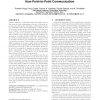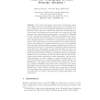250 search results - page 49 / 50 » More on the Security of Linear RFID Authentication Protocols |
OOPSLA
2007
Springer
14 years 1 months ago
2007
Springer
Objects often define usage protocols that clients must follow in order for these objects to work properly. Aliasing makes it notoriously difficult to check whether clients and i...
SP
2009
IEEE
14 years 2 months ago
2009
IEEE
– HTTPS is designed to provide secure web communications over insecure networks. The protocol itself has been rigorously designed and evaluated by assuming the network as an adve...
PODC
2009
ACM
14 years 8 months ago
2009
ACM
Global consistency or Byzantine Agreement (BA) and reliable point-to-point communication are two of the most important and well-studied problems in distributed computing. Informal...
ESAS
2004
Springer
14 years 24 days ago
2004
Springer
The common perception of public key cryptography is that it is complex, slow and power hungry, and as such not at all suitable for use in ultra-low power environments like wireless...
SP
2005
IEEE
14 years 1 months ago
2005
IEEE
So far, sensor network broadcast protocols assume a trustworthy environment. However, in safety and missioncritical sensor networks this assumption may not be valid and some senso...



